
The Untamable Beauty of California’s Wildflowers

Contributor
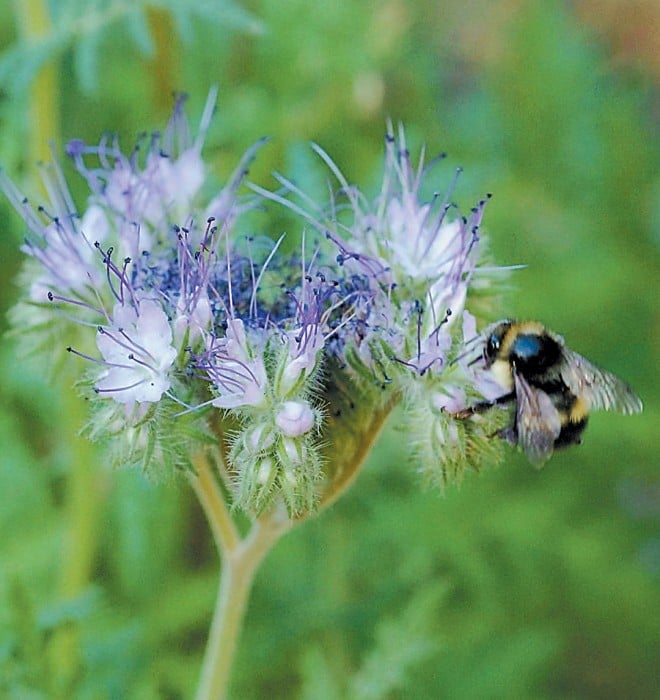
Many of us who strive to enhance the habitat value of our gardens are also amateur naturalists, wishing to make nature a more integral part of our everyday lives. Nothing is quite as evocative of California’s glorious natural attributes as the ephemeral beauty of her native annual wildflowers. In the habitat garden, these annuals enhance the foraging conditions for wildlife by their speedy production of pollen, nectar, and seeds—each plant’s life cycle perfectly attuned to our climate and the needs of our wild creatures.
California was the “golden west” long before the Gold Rush. Spanish missionaries admired the vast, uninterrupted fields of orange poppies; they were copa de ora or “cups of gold” to the Spaniards. Native Peoples found the orangey sap of the perennial root useful as a topical anesthetic, particularly for toothaches, and they harvested the fresh young leaves to eat as cooked greens. Deer browse the new growth of poppies in my garden early in the season, and then move on to other forage. The poppies respond with a renewed vigor, producing masses of flowers. Tiny insects can often be seen sheltering in the cupped flowers, the temperature inside being warmer than the ambient temperature outside. Later, deer browse the un-ripened seedpods; after the remaining seeds mature, I can cut each plant back to encourage another cycle of bloom.
Many of our wildflowers have colorful names eliciting pictures of California’s history. Clarkia was named for William Clark, who along with Merriwether Lewis, explored and botanized much of the West. Quaint common names were given to some of the many species of Clarkia, such as farewell-to-spring (C. amoena) and red ribbons (C. concinna). We have showy red maids (Calandrinia ciliata) and milkmaids (Cardamine californica) with dainty white flowers. The shape of Chinese houses (Collinsia heterophylla) must have reminded someone of a pagoda; and popcornflower (Plagiobothrys spp.), and cream sacs (Castilleja rubicunda) could well have been named by hungry pioneers!
Gilia was named for EF Gil, a Spanish botanist of the late eighteenth century. California poppy (Eschscholzia californica) was named for JF Eschscholtz, a German physician, by the German botanist LK Chamisso, who discovered the poppy growing on San Francisco’s sand dunes in 1816.
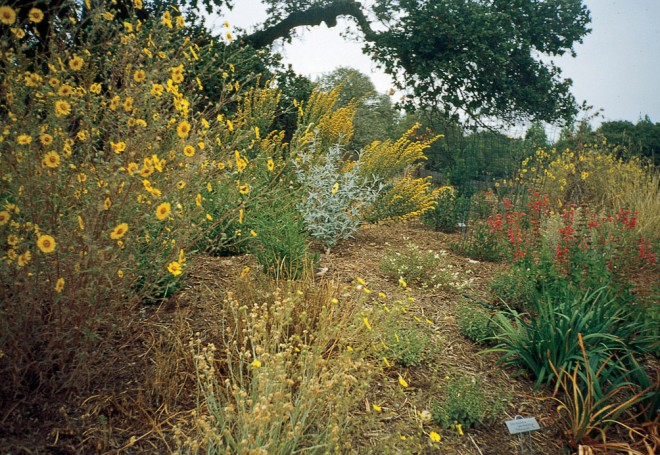
Wildflowers and Fire
The native peoples made use of wildflower seeds, collected along with the grains of native grasses, to create their pinole, or seed cakes. The taste of tarweed (Madia spp.) seeds was described as “rich as butter.” Seeds of red maids, tidy-tips (Layia platyglossa), buttercups (Ranunculus spp.), lupines (Lupinus spp.), and clarkias were also harvested. Controlled burns of meadows and fields were employed as a tool to promote the growth of these important food crops. Burning removed the thatch from the perennial bunchgrasses and enriched the soil, creating a perfect seedbed for the annuals. Seed of desired species was held back from the food store and broadcast on the fields to ensure another harvest.
Ecologically speaking, a grassland fire would be a natural disaster of medium intensity, and the best way to promote biological diversity. I try to keep that in mind as I organize my gardening efforts to be sustainable. I mimic the natural process of succession, playing the role of a “natural disaster” as I slowly cultivate more areas of a two-acre hillside. Annuals are the first to colonize a disturbed piece of land, their short lives adding organic content to the soil. Some of these pioneering species, such as lupines and vetches (Vicia spp.) also enhance fertility by fixing nitrogen in the soil. All of these annuals help build a soil environment that will eventually support the growth of perennials and woody plants.
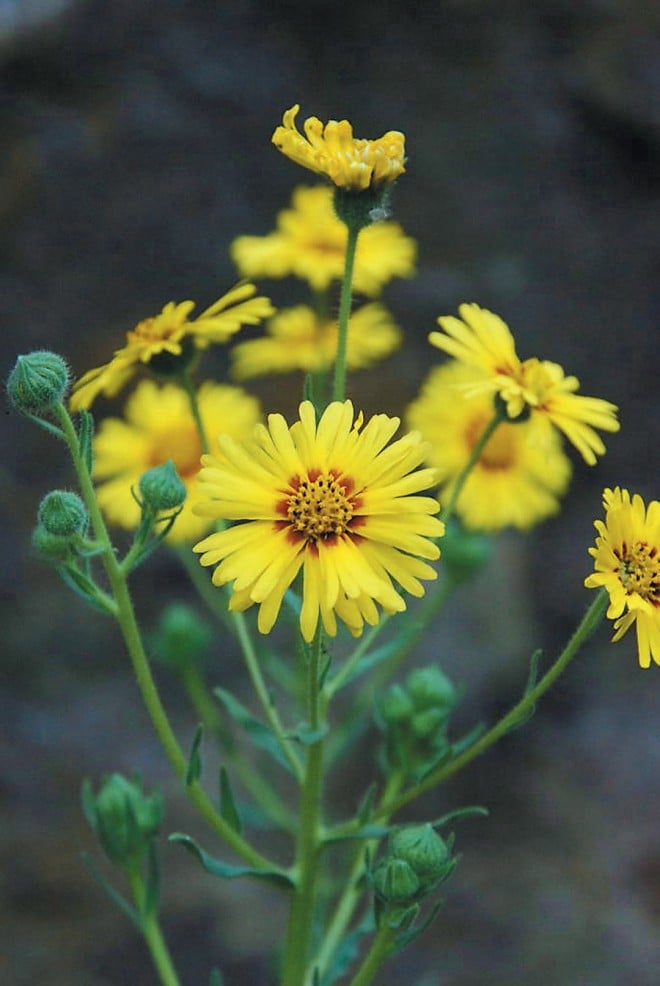
A Program for Seeding
The various steps to the successful seeding of wildflowers can be most comfortably accomplished a little at a time, and over a period of time. Whether you garden a couple of hillside acres like I do, or want to create habitat in a suburban lot, the coming rainy season is the perfect time to bring in a bit of California’s wilder side. Wildflowers can also be seeded in as filler in a perennial border, or mixed into a grass garden with a few native bulbs for a really natural look.
My Novato hillside is blessed with flourishing stands of purple needlegrass (Nasella pulchra), along with a good many introduced annual grasses. Native iris (Iris douglasiana), brodiaeas (Brodiaea, Dichelostemma, and Triteleia spp.), and mariposa lilies (Calochortus spp.) are also scattered across the hillside. Seeds of the annual grasses germinate after the first light rains, and that is the perfect time to start preparations for wildflower seeding. First, I mark all the needlegrass clumps, in order to avoid disturbing them too much; these, and a number of other native grasses, are a perfect complement to the wildflowers. Soap plant (Chloragalum pomeridianum) is also abundant here, and I take care to work around them; where they are particularly numerous, I dig up some of the dormant bulbs and transplant them to other locations on the hillside.
I start with a pitchfork to loosen up the clay soil, which is typical of much of Marin County. It takes some effort to push the tines all the way into the ground, but then I can rock the fork back and forth and, utilizing the leverage of the handle, lift up clumps of the weedy grasses to open up air pockets under the roots. I do not turn these clumps over, merely lift them, trying to disturb the soil structure as little as possible. Exposing the roots this way quickly kills the freshly germinated exotic grasses.
The next step, which can be days later and is best done right after another rainfall, is to work these clumps with a hand fork, hacking out the roots of the grasses. The weedy seedlings are removed and used to mulch other plantings close by. I then loosen the soil to a depth of about three inches, taking time to break up the larger clumps of soil. A generous sprinkling of rock dust adds trace minerals, and a topdressing of compost replaces the organic matter that I’ve removed. All this is then gently worked into those top few inches of loosened soil.
One tablespoon of seed mix will cover about a hundred square feet. I blend it with clean river sand at the rate of about two gallon pots of sand for each tablespoon of seed. This mixture is then broadcast over the prepared surface, the sand helping to ensure a more even distribution of the seeds. Then I walk all over the seedbed to insure a good seed-to-soil contact. Covering it all over with a thin layer of mulch, either straw or chipper bark, helps to protect the seeds from foraging birds, and retains some moisture for newly emerging seedlings. If the rainy season is on cue, all I have to do is some occasional weeding If the rains are tardy or erratic, I water weekly once germination starts. Without water, the wildflowers will go through their life cycle too quickly; a little supplemental irrigation promotes the growth of really magnificent specimens and a prolonged flowering season.
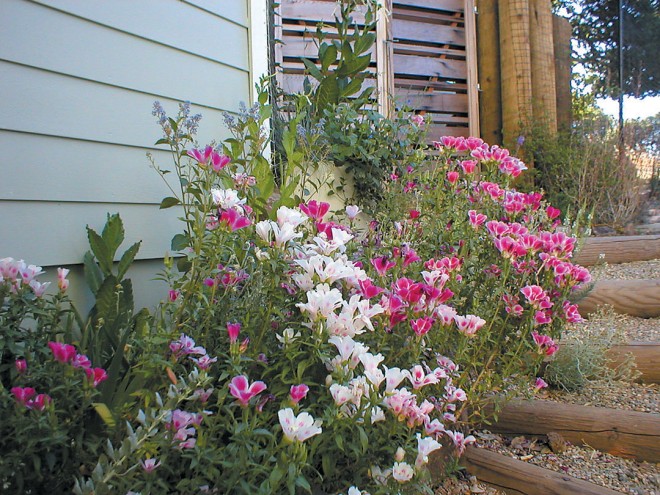
A Full Season of Flowers
My basic seed mix is a purchased blend of about a dozen species, including some from other parts of the state. To this mix, I add seed of common madia (Madia elegans), cobwebby thistle (Cirsium occidentale), and a beautiful little lemon yellow tarweed (Hemizonia sp), which I collected nearby and have yet to completely identify. This seed mix provides flowers from early March, starting with all the blue, purple, and yellow flowers of globe gilia (Gilia capitata), lupines, phacelias (Phacelia spp.), tidy tips, and goldfields (Lasthenia spp.). Honeybees and bumble-bees work these flowers from early morning on. Once a lupine flower has been pollinated, its color changes to white, and the bees ignore it. Clarkias come into bloom next, different species creating a show from late spring to summer. Almost immediately, I notice neat rounds cut from the petals, the work of leafcutter bees. I watched as one provisioned a nesting hole using sections of pale lilac petals to create cells for its larvae. A few days later, the hole was sealed with small globs of plant material. I’ll keep a watch for the emergence of the next generation.
The tarweeds (Madia and Hemizonia) extend the wildflower season right through the fall. The plants are highly resinous, which helps make them extremely drought tolerant. On hot summer days, the resins perfume the air with a musty honeyed scent, and the flowers attract insects when little else is blooming. In some areas of my garden, madia is deer browsed for a while; the plants then become multi-branched and wonderfully floriferous. Incorporating these annual beauties into the garden is not for gardeners who dream of control, or a finished manicured look in the garden. Wildflowers are part of the process of letting go; the gardener becomes a participant in an ever-changing process of re-inhabitation of the land. A broad variety of invertebrates become evident as each flowering species, in turn, offers a bounty of pollen, nectar, leaf, and seed; this abundance soon brings in the foraging birds.
Birds add much life, beauty, and constant activity to my garden, and they come bearing gifts! Surprise packages of seed, gathered from nearby wildlands, and wrapped with fertilizer, are often left for me near the birdbath. I recently potted up a number of healthy madrone (Arbutus menziesii) seedlings that had germinated under the birdbath; perennials like gumweed (Grindelia spp.) and sun cups (Camissonia spp.) were left to grow where the birds planted them.
Now much of the work in my garden is simply a matter of facilitating—managing the ever- increasing fecundity in the hopes of recreating on my hillside a representation of California’s diverse floristic province—one of the richest in the world.
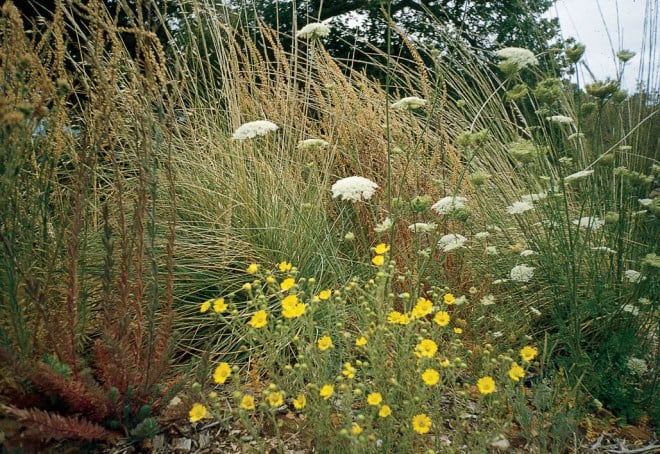
Wildflower Seed Mixes
My “basic wildflower seed mix” is purchased from Harmony Farms (www.harmonyfarm.com or 707/823-9125). Their Native California Wildflower Seed mix contains farewell-to-spring, mountain garland, Chinese houses, California poppies (dwarf and normal varieties), globe gilia, bird’s eye gilia, goldfields, tidy tips, mountain phlox, blue flax, yellow and arroyo lupine, baby blue-eyes and baby five-spot, California blue bells, and blue-eyed grass. Harmony Farms also offers seed of some wildflower species separately.
Seed of individual species can also be purchased from Wildseed Farms (www.wild seedfarms.com or 800/848-0078).
Seed of native perennial grasses can be purchased from Larner Seeds in Bolinas (415/868-9407).
As you might have guessed, I am a compulsive collector of seeds; many of these are packaged and offered for sale at Marin Art and Garden Center education programs. For more information about the center’s programs, visit www.magc.org.
Share:
Social Media
Garden Futurist Podcast
Most Popular
Videos
Topics
Related Posts

Low Maintenance Gardens – Better for Pollinators and People
Autumn 2022 “I come out every day. It’s therapy, my meditation.” Janet’s young garden transformed from overgrown, invasive plants to mostly natives. The dailiness of

Invasive Plants Are Still Being Sold: Preventing Noxious Weeds in Your Landscape
Autumn 2022 With so many beautiful ornamental plant species and cultivars throughout California and the Pacific Northwest, how do you decide which ones to include

Garden Design in Steppe with Transforming Landscapes with Garden Futurist Emmanuel Didier
Summer 2022 Listen to full Garden Futurist: Episode XVII podcast here. Emmanuel Didier, Principal and Creative Director at Didier Design Studio is a leading figure
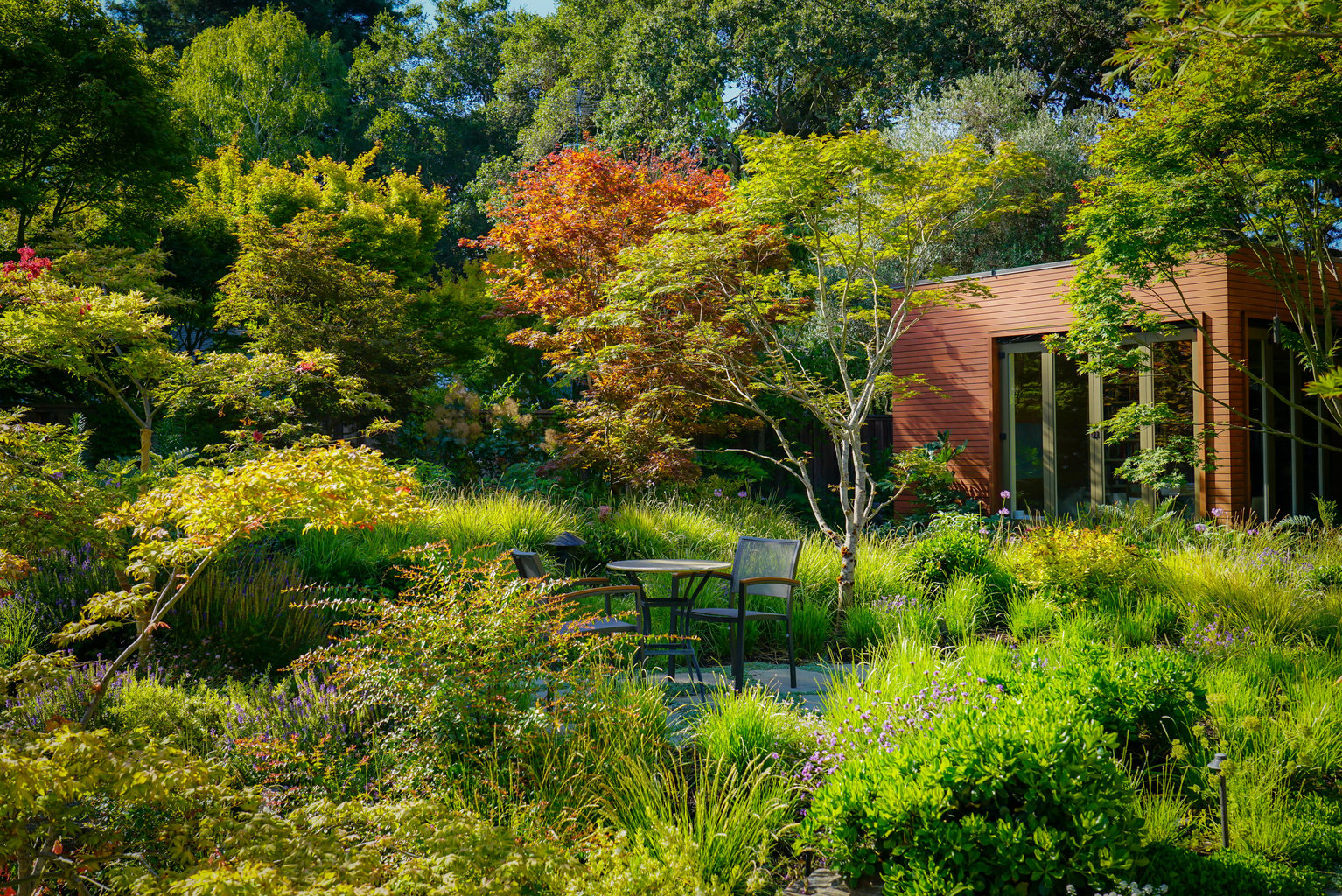
Seslerias: Versatile Groundcover Meadow Grasses
Summer 2022 Without question, the most beautiful and versatile of all the groundcover meadow grasses are the moor grasses (Sesleria). Moor grasses tick off all










Responses